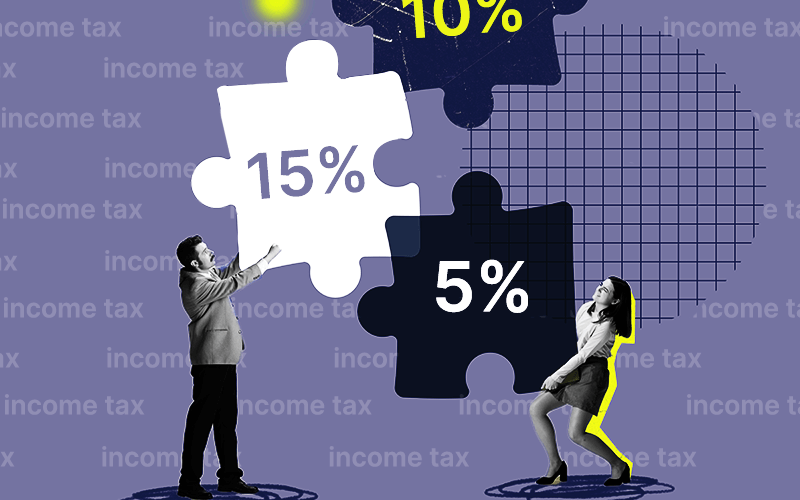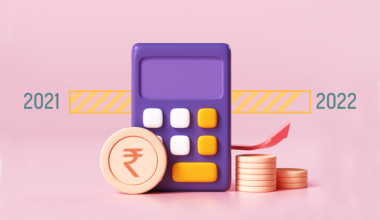Every salaried individual needs to pay income tax based on the slab system they fall under. The income tax is imposed on the income earned by all individuals, HUF, partnership firms, corporates and LLPs as per the Income Tax Act of India. The income tax slab shows different tax rates prescribed for different ranges of income.
As per the current budget 2022, no changes have been made to the income tax bracket. The new income tax regime was introduced in budget 2020, which came into effect from the financial year 2020-21. The taxpayers can choose between the old regime, which includes various deductions and exemptions and the new regime which offers lower tax rates for those who are willing to forgo exemptions and deductions. Let’s take a look at the new income tax slab rates for FY 2021-22 & AY 2022-23.
Income Tax Slab Rate for FY 2021-2022- Applicable for New Tax Regime
| Income Slab (in Rs.) | Income Tax Rate |
| Upto 2,50,000 | NIL |
| 2,50,000- 5,00,000 | 5% of the amount exceeding Rs. 2,50,000 (Tax rebate U/S 87A is available) |
| 5,00,000- 7,50,000 | 10% of the amount exceeding Rs. 5,00,000 + Rs. 12,500 |
| 7,50,000- 10,00,000 & above | 15% of the amount exceeding Rs. 7,50,000 + Rs. 37,500 |
| 10,00,000 – 1,250,000 | 20% of the amount exceeding Rs. 10,00,000 + Rs. 75,000 |
| 12,50,000-1,500,000 | 25% of the amount exceeding Rs. 12,50,000 + Rs, 1,25,000 |
| 1500,000 & above | 30% of the amount exceeding Rs. 1,500,000 + Rs. 1,87,500 |
Note:
- The tax rates in the new tax regime are the same for all categories of individuals i.e. individuals & HUF up to 60 years of age, senior citizens above 60 years to 80 years of age and super senior citizens above 80 years of age. Thus, no benefit of increased basic exemption limit benefit will be available to senior and super senior citizens in the new tax regime
- Individuals with net taxable income less than or equal to Rs. 5 lakh will be eligible for tax exemption U/S 87A of the IT Act. The tax liability will be nil for such individuals in both new and old tax regimes
- Irrespective of age, the basic exemption limit for NRIs is of Rs. 2.5 lakh
- In all cases, additional health and education cess of 4% will be added to the income tax liability
- A surcharge is applicable as per the tax rates mentioned above in all categories
- 10% of income tax where total income exceeds Rs. 50,00,000
- 15% of income tax where total income exceeds Rs. 1,00,00,000
- 25% of income tax where total income exceeds Rs. 2,00,00,000
- 37% of income tax where total income exceeds Rs. 5,00,00,000
Conditions for Opting New Tax Regime
The taxpayers opting for lower rates in the new tax regime will have to forgo certain deductions and exemptions available in the old tax regime. In total, there are 70 exemptions and deductions that are not allowed. Let’s take a look at the list of most commonly used exemptions and deductions-
| List of Common Exemptions and Deductions ‘Not Allowed’ Under New Tax Rate Regime | List of Common Exemptions and Deductions ‘Allowed’ Under New Tax Rate Regime |
| House Rent Allowance (HRA) | Conveyance allowance for expenditure incurred for traveling to work |
| Leave Travel Allowance (LTA) | Transport allowance for specially-abled people |
| Relocation Allowance | Deduction for employment for new employees U/S 80JJAA |
| Conveyance Allowance | Investment in Notified Pension Scheme U/S80CCD(2) |
| Daily Expenses in course of employment | Any allowance for traveling for employment or on transfer |
| Other Special Allowance [Section 10(14)] | Depreciation U/S 32 of the Income Tax Act except for additional depreciation |
| Children education allowance | |
| Standard Deduction on Salary | |
| Interest on Housing Loan (Section 24) | |
| Deduction under chapter VI-A (section 80C, 80D, 80 E and so on) ( Except section 80CCD(2)) |
New Tax Slab Rates for Domestic Companies for FY 2021-22
| Particulars | New Tax Regime Rates |
| The company opts for section 115 BAB(Not covered in section 115BA & 115 BAA) & is registered on or after 1st October 2019 and has commenced manufacturing on or before 31st March 2023 | 15% |
| Companies opt for Section 115 BAA, wherein the total income of a company has been computed without claiming specific incentives, deductions, additional depreciation and exemptions | 22% |
| The company opts for Section 15BA registered on or after March 1st 2016and engaged in the manufacture of any article or thing and does not claim a deduction as specific in the section clause | 25% |
| Gross receipt or turnover of the company is less than Rs. 400 crore in the previous year 2018-19 | 25% |
| Any other domestic company | 30% |
Surcharge:
| Company | Range of Total Income | ||
| Rs. 1 crore or less | Above Rs.1 crore but upto Rs. 10 crore | Above 10 crore | |
| Domestic company opting for section 115BA | Nil | 7% | 12% |
| Domestic company opting for section 115 BAA | 10% | 10% | 10% |
| Domestic company opting for section 115 BAB | 10% | 10% | 10% |
| Any other domestic company | Nil | 7% | 12% |
*Health and Education Cess:- 4% of income tax and surcharge
Income Tax Rate for FY 2021-22 & AY 2022-23 for Partnership Firm as per Old/ New Regime
A partnership firm including Limited Liability Partnership (LLP) is taxable at 30%. Plus, a surcharge of 12% of tax is applicable where the total income exceeds Rs.1 crore.
Note- There are no concession rates introduced for LLPs/ firms in the new tax regime.
Old Tax Regime Vs New Tax Regime, Which is Better?
The new tax regime can be beneficial for middle-class taxpayers who have a taxable income of up to Rs. 15 lakh. The old regime is a better option for high-income earners.
The new tax regime includes seven lower income tax slabs, thus it is beneficial for taxpayers who make low investments. Any individual paying taxes without claiming any tax exemption can benefit from new tax slab rates. For example- a taxpayer having a total income of up to Rs. 12 lakh before deduction will have a higher tax liability under the old tax regime if he/she has investments less than Rs.1.9 lakh. Thus, individuals who invest less in tax-saving schemes should go for the new regime.
On the other hand, for taxpayers who have a strong investment portfolio and have invested in various tax saving instruments such as mediclaim, life insurance, ULIP, payment of children tuition fees, payment of EMI on education loan, purchasing a house with a home loan, etc. should opt for the old tax regime as it helps with a higher tax deduction and lower tax outgo.
Overall, it is important to do a comparative analysis and evaluation of both regimes to choose the most beneficial one as per one’s own requirements and suitability.
Let’s take an example of the old & new tax regime of an assessee with Rs. 10 lakh income-
Mr. Vikas has a salary income of Rs.10 lakh. His total investment under Section 80C is Rs.1.7 lakh under ELSS, LIC Premium, PF and principal installment of home loans. Besides this, he pays a medical insurance premium for himself and his wife of Rs. 28,000. If Mr. Vikas chooses the old tax regime, he can claim the above deductions; however, if he wishes to go for a new regime then these deductions will not be available. Note that Mr. Vikas has also paid a home loan interest of Rs. 75000 in FY 2021-22. Let’s take a look at the tax outlook in both the regimes
| Particulars | Old Tax Regime (in Rs.) | New Tax Regime (in Rs.) |
| Gross Income | 10,00,000 | 10,00,000 |
| Deductions: | ||
| U/S 80C | 1,50,000 | |
| U/S 80 | 25,000 | |
| U/S24(b) | 75,000 | |
| Taxable Income | 7,50,000 | 10,00,000 |
| Tax Slab (OLD) | ||
| 0-2.5 lakh | – | – |
| 2.5 lakh – 5 lakh @5% | 12,500 | – |
| 5 lakh – 10 lakh @20% | 50,000 | – |
| >10 lakh @ 30% | – | – |
| Tax Slab (New) | ||
| 0- 2.5 lakh | – | – |
| 2.5 lakh – 5 lakh @5% | – | 12,500 |
| 5 lakh- 7.5 lakh @10% | – | 25,000 |
| 7.5 lakh- 10 lakh @15% | – | 37,500 |
| 10 lakh – 12.5 lakh @ 20% | – | – |
| 12.5 lakh- 15 lakh @ 25% | – | – |
| >15 Lakh @ 30% | – | – |
| Income Tax | 62,500 | 75,000 |
| Cess @4% | 2,500 | 3,000 |
| Total Tax Outgo | 65,000 | 78,000 |
According to this table, if the gross income is above Rs. 10 lakh or deductions U/S 80C, 80D and 24(b) of the Income Tax Act has been availed, then the older regime is more beneficial for tax planning. While for taxpayers with middle income, earning a gross income of Rs. 5 lakh, the new tax slab regime may prove to be more beneficial.





